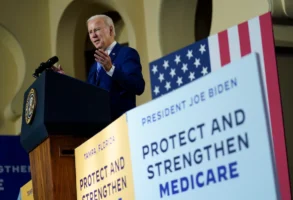
Published January 14, 2016
National Review - January 25, 2016 issue
Thanks to Donald Trump, American elites are finally paying attention to blue-collar, white America. They do not like what they see.
Racist. Bigoted. Irrational. Angry. How many times have you read or heard one or more of these words used to describe Trump’s followers? Whether they are the academic, media, and entertainment elites of the Left or the political and business elites of the Right, America’s self-appointed best and brightest uniformly view the passions unleashed by Trump as the modern-day equivalent of a medieval peasants’ revolt. And, like their medieval forebears, they mean to crush it.
That effort is both a fool’s errand for the country and a poisoned chalice for conservatives and Republicans. It is foolish because the reasons the peasants are revolting will not fade easily. Ignoring and ridiculing their concerns, the way European elites have done with their own electorates for most of the last two decades, will simply intensify the masses’ rage and ensure that their political spokesmen become more intransigent and radical. If you want an American version of Marine Le Pen tomorrow, ignore the legitimate concerns of blue-collar Americans today.
And it is a poisoned chalice for the Right because such a strategy requires a permanent informal coalition with the Left. Keeping blue-collar white Americans out of political power will result in exactly what Washington elites have wanted for years: a series of grand bargains that keep the status quo largely intact and the Democratic party in power.
Conservative Republicans have fought for 60 years to build a coalition that not only will tell history to stop, but will also channel it in a new direction, a direction in which freedom flourishes and America and her values reign over a peaceful and prosperous globe. The constituency that is rallying to Trump is not fully conservative, but it shares more values with conservatives than do any of the other constituencies that could possibly be enticed to join our cause. It is thus imperative that conservatives understand what these fellow citizens want and find ways to make common cause with them where we can.
Blue-collar whites traditionally have been animated by the sense that government ought to be on the side of the little guy. They formed the backbone of the Democratic party during its New Deal/Great Society heyday, enthusiastically supporting a party that aided labor unions, created Social Security and Medicare, and expanded educational opportunities. While they no longer think of themselves as Democrats, they have not abandoned either these sentiments or the promises that these programs originally offered. Their openness to the Right is predicated on the Right’s guaranteeing that these advances will not be undone.
Patriotism has also been a blue-collar-white staple for decades. Blue-collar whites may not be particularly hawkish (their sons and daughters are often our “boots on the ground”), but they are not isolationist or pacifist, either. They are proud of America, favor effective measures to protect our security, and do not like to see America humiliated by her enemies.
Blue-collar whites remain more friendly to traditional religion than other, more educated groups but are not as motivated by social issues as they were 30 to 40 years ago. Whites without a college degree who remain motivated by these issues are already staunch Republicans. Those who remain independent tend to be open to candidates’ espousing traditional social values but do not prioritize those values highly when choosing whom to vote for.
Today these voters are most animated by a sense that they are being left behind by a changing America. They have good reason to think so: Americans with less than a college education have seen their incomes stagnate or decline for more than 15 years. Inflation-adjusted median incomes peaked for these men and women in 1999, during the Clinton administration (expect to hear a lot about that if Hillary is the Democratic nominee). Neither the Bush nor the Obama years have been good for them.
This has not made them want to overhaul America’s private sector. Polls show that blue-collar whites still believe in free enterprise and distrust government solutions. They do not believe, however, that the current economy is serving them well.
These developments have led them to be among the most pessimistic of all American voter groups. Pew Research broke the American electorate into eight groups in 2014, and the one that contains blue-collar white swing voters — “Hard-Pressed Skeptics” — was solidly down on their own future and on America’s. Sixty-one percent said America’s best years are behind us, and 65 percent said that hard work and determination are no guarantee of success.
These voters also do not trust either Wall Street or the American economy more generally to provide for their future. Seventy-four percent say that our economy unfairly favors powerful interests, and 54 percent say Wall Street hurts America’s economy. In each case, only “Solid Liberals” expressed more negative, anti-business views.
Trump’s opposition to immigration and suspicion of free trade have been his calling cards so far, so it should be no surprise to find that blue-collar white independent voters share his views. The Pew study found that 79 percent think immigrants are a burden on the country and 44 percent think free-trade agreements are bad for America. These voters have been hit hard by competition from foreigners, whether those foreigners live abroad (free trade) or at home (immigrants), and they want protection — now.
Blue-collar whites are also more open to government action than many movement conservatives. For example, 87 percent of “Steadfast Conservatives,” Pew’s term for movement conservatives, think government is doing too much that should be left to individuals and businesses; only 44 percent of Hard-Pressed Skeptics agree. Sixty percent of Hard-Pressed Skeptics think government aid to the poor does more good than harm; only 10 percent of Steadfast Conservatives agree. Seventy-nine percent of Hard-Pressed Skeptics say that cuts to Social Security benefits should be off the table. Clearly a campaign based on cutting food stamps and reforming entitlements will not resonate with blue-collar whites.
One might wonder whether meeting these voters halfway is worth it. But there is no alternative: All other voter groups who might be open to voting for a Republican nominee are farther to the left and oppose conservative consensus on key matters of principle.
Hispanics, for example, strongly favor government intervention in the economy. The Public Religion Research Institute has found that Hispanics favor raising taxes and increasing spending on education and infrastructure by a nearly two-to-one margin over cutting taxes and letting business grow. Upper-income young whites, whom Pew calls the “Next Generation Left,” favor free trade and low taxes but are highly secular and green, opposing the traditional definition of marriage and favoring greenhouse-gas-emission controls. These voters will vote for Republicans, but only for moderates such as former New York governor George Pataki or former California governor Arnold Schwarzenegger. Building a working coalition by focusing on either of these groups, as many in the GOP establishment favor, would trigger a civil war within conservatism.
Winning the support of blue-collar voters means gaining their trust, and that means first affirming the core elements of their worldview. They have to believe that the GOP nominee understands that they have been the losers in the transition to a modern economy. They have to believe that the nominee will be on their side when the chips are down and that he is willing to take on the powerful. A nominee who appears ignorant of or callous toward these views, such as Mitt Romney, will be rejected as long as the Democratic nominee seems marginally acceptable.
This means that they will demand, at a minimum, some form of immigration restriction. America undoubtedly needs some immigrants to fuel its economic growth, especially since the native-born work force is aging. But “open borders” as an end goal of immigration reform will simply not fly with these voters.
The nominee should be guided by the principle “All the immigrants we need, but only the immigrants we need.” That means he or she should favor getting control of our borders and enforcing requirements to give American citizens priority for job openings. It may also mean reforms that help citizens move in search of work. Low-skilled, native-born Americans tend to stay in place when jobs leave their communities, a choice partially subsidized by a host of well-meaning government programs that allow them to get by without moving. Reforming these programs to encourage Americans to move where the jobs are will lower the demand for immigration and give blue-collar Americans of all races the help they need to get back on the ladder to self-sufficiency.
Addressing the downside of free trade is also key to winning these voters. Restricting trade itself is not a good idea, since trade creates jobs that these voters need. But free-trade competition places downward pressure on the wages and compensation of low-skilled workers. A GOP nominee who wants to attract these voters must embrace an economic policy that creates high-paying jobs that people with high-school educations can do.
This will require more than simply lowering corporate tax rates to encourage business investment, although it certainly does require that. It will require more than making it easier to produce oil, natural gas, and other natural resources that create good jobs for people with moderate levels of formal education. Ideally, it will involve enacting some policies that favor or subsidize high-paying jobs in America.
That could take many forms, but Wisconsin governor Scott Walker’s tax reforms give some idea of what one can do. He has not cut corporate tax rates in Wisconsin. Instead, he has enacted two tax credits that reward businesses for jobs they create and for in-state business activity. Federal corporate tax credits for companies that create jobs in America, and perhaps for companies that increase employee compensation beyond the rate of inflation, would show blue-collar Americans that the government is working for them.
Blue-collar voters also need to know that “playing by the rules” will be rewarded, not punished. Some of the major objections they have to immigration and trade arise from the fact that our government looks the other way at cheating when it comes to foreigners (e.g., Chinese currency manipulation and businesses’ hiring illegal immigrants) but rigorously enforces the rules when it comes to Americans. To blue-collar whites, “working hard and playing by the rules” is a core value; a government that doesn’t share it is one that earns scorn and merits disgust. A GOP nominee who wants to win these voters over will have to show he is serious about creating economic rules that don’t disfavor American workers and will be enforced.
It is also possible to find common ground with these voters on tax policy. They will support tax cuts for everyone, even the “top 1 percent,” but they will not support tax cuts that seem unduly to favor the already well-to-do. This is a problem for most Republican candidates, because they have already endorsed tax policies that embrace the supply-side view that the best way to grow the economy is to cut taxes for the highest earners.
A politically ideal tax policy would look less like what is on offer now and more like what has worked for Governors Walker and Kasich (Ohio). Both Walker and Kasich have cut tax rates for all, but their cuts are much smaller than those that the other major candidates have proposed. Each of their state tax-cut plans also includes elements that backload the cuts in favor of working-class households — in Kasich’s case, an increase in the earned-income tax credit, and larger rate cuts for lower income brackets in Walker’s. A politically ideal tax plan would adopt similar approaches.
A bold nominee might even want to propose exempting the first $20,000 in wages from the Medicaid payroll tax, which would lower the cost of hiring a new employee and nearly eliminate this tax for most households earning less than the median income. This exemption would apply to all workers, so higher-income taxpayers would see their taxes cut too; but it would apply equally to all rather than give a greater benefit to people who are already doing well. It would be a federal version of the across-the-board property-tax cuts that Scott Walker has enacted with great success, cuts that benefit all and give equal treatment to people in all income brackets.
The same basic approach extends to a host of other issues. Higher education, for example, costs so much because academic elites keep out competitors and prop up tenured faculty who teach and publish very little. Deregulation and tying federal student aid to keeping tuition increases at or below inflation will give blue-collar students the education they want at a price they can afford.
Obamacare should be repealed and replaced, but with an eye more on how its replacement will work in practice than on how it looks in theory. That means designing a plan that subsidizes private-sector coverage and deregulates health-insurance and health-care markets to incentivize the private sector to deliver care more efficiently.
Conservatives can achieve all this while advancing freedom and opportunity. Ronald Reagan built his career on that understanding. Writing in these pages in December 1964, he asserted that conservatives “represent the forgotten American — that simple soul who goes to work, bucks for a raise, takes out insurance, pays for his kids’ schooling, contributes to his church and charity and knows there just ‘ain’t no such thing as free lunch.’” Reagan spent the rest of his career representing that soul, and in so doing created the modern conservative movement and changed the world. We who stand on his shoulders would do well to readopt the sentiments that allowed him to attract the blue-collar Reagan Democrats and remake his coalition in our times.
– Henry Olsen is a senior fellow at the Ethics and Public Policy Center. This article originally appeared in the January 25, 2016, issue of National Review.








